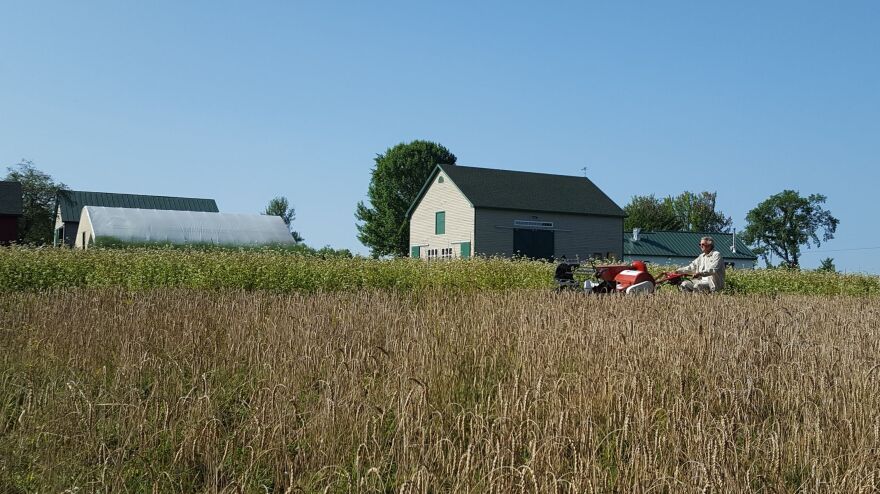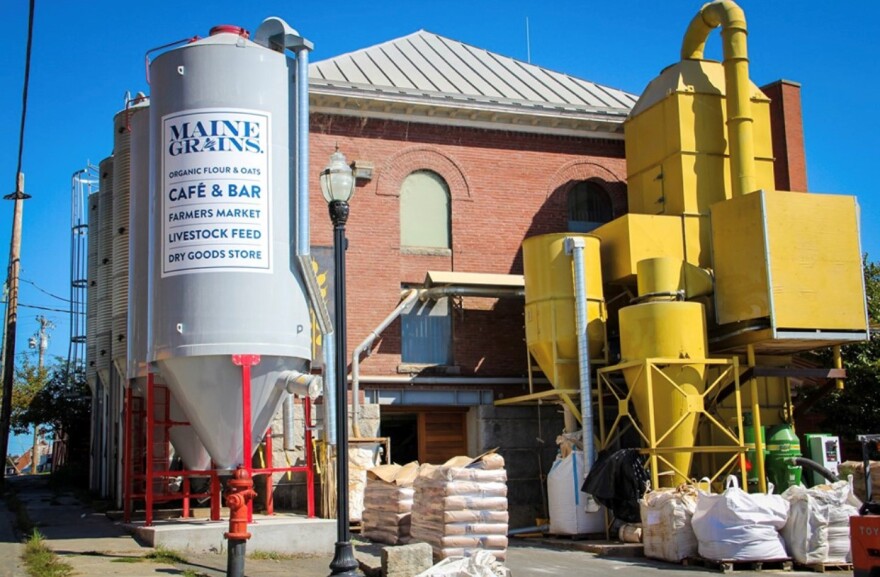Climate change impacts farmers and global supply chains. Maine’s growing grain economy could help

Richard Roberts, director of the Maine Grain Alliance Heritage Seed Restoration Project, using a combine to harvest Warthog at a small plot on Blue Ribbon Farm in Somerset County. A cover crop of Buckwheat also grows in the background. (Mary Burr / Blue Ribbon Farm)
Sean O’Donnell started growing grains about 10 years ago at Rusted Rooster Farm, 45 minutes north of Skowhegan on the border of Maine’s Somerset and Piscataquis counties. He began on a small scale, using grains as a cover crop planted in rotation with other crops to improve the health of the soil.
He and his wife now grow about 150 acres of organic grains including Red Fife Wheat, Winter Rye, oats, and barley. That’s up from around 40 acres just five years ago. O’Donnell credits this growth, in part, to Maine’s burgeoning grain economy.
“It’s growing more and more. I don’t think I could do what I was doing 10 years ago, and that credit goes to the grain economy,” O’Donnell said.
But that regional grain economy is also providing a buffer to extreme fluctuations in prices, crop failures and supply chain issues linked to climate change.
“As we get thrown more and more severe weather, we need to learn how to have a successful crop in all conditions, and having that guaranteed market and decent profitability is huge to have that resilience,” O’Donnell said.
In fact, it’s already been put to the test by another global crisis. During the early months of the coronavirus pandemic, many consumers in Maine turned to a local Skowhegan grist mill, Maine Grains, to meet their flour needs.
“Flour ran out of the shelves at grocery stores from industrial milling locations because there was a lag in big mills’ ability to keep up with consumer need and demand. That was a resilient moment for us, even just having the regional supply chain and infrastructure,” said Amber Lambke, co-founder and owner of Maine Grains. Lambke and her business partner Michael Scholz started the operation in 2012 after purchasing the old jail in Skowhegan and converting it to a grist mill.
Maine Grains processes flour, oats, wheat berries, rye, cornmeal, buckwheat and more, and the products are sold throughout the state and northeast. The grains are also used for local malting and distilling, animal feed, and seed markets.

Maine Grains grist mill facility in Skowhegan, Maine in Somerset County. (Courtesy of Maine Grains)
“Maine was considered the breadbasket of New England in the 19th century,” Lambke said. And, she said, Somerset County’s grain economy has deep historical roots.
Somerset County was producing 239,000 bushels of wheat per year at its peak in 1837, which was enough to feed more than 100,000 people, Lambke said.
“If you go back to the late 1800s in Somerset County and central Maine, you had all kinds of grist mills dotting the countryside that were taking locally grown grain and milling them for [local use],” said Tristan Noyes, executive director of the Maine Grain Alliance, a nonprofit focused on building the regional grain economy across the state.
Grain farmers in Aroostook County have continued to grow grain for hundreds of years, mostly as cover crops to support their more lucrative potato fields, but grain production in Somerset County and central Maine mostly disappeared as the industry centralized around large-scale production in the Midwest. The milling infrastructure was also lost over time, along with much of the knowledge of how to grow grains, which the Maine Grain Alliance is now trying to restore.

Emmer wheat during pollination. Richard Roberts, director of the Maine Grain Alliance Heritage Seed Restoration Project, planted this grain variety in Somerset County as part of the Alliance’s seed restoration and grow out program. (Courtesy of Richard Roberts)
Lambke and others formed the Alliance in 2007 by starting the Kneading Conference, an annual gathering of grain farmers, bakers, brewers, millers and the public each summer in Skowhegan.
The Somerset Grist Mill at Maine Grains is one of two local grist mills in the state which focus on processing organic grains; the other is Aurora Mills in Aroostook County
All told, Maine grows about 50,000 acres of oats, barley and common wheat annually, according to the United States Department of Agriculture’s most recent census figures. A small, but increasing, portion of that is grown organically, Noyes said. That’s helped create new markets and an increasing demand for sustainable, locally grown grains.
“What has been enabled by mills like Aurora Mills and Maine Grains in central Maine is that there is no longer just the one commodity market to which those grains can be sold, they can be sold into these local markets,” Noyes said.
“People really like the idea of eating local. If you develop a local grain economy, with relationships between farmers and processors, then you can stabilize prices and provide some predictability for farmers in terms of a price and in terms of volume [that they can sell],” said Ellen Mallory, a University of Maine Extension professor in the School of Food and Agriculture. She’s also on the board of Maine Grain Alliance and works with farmers to help them meet the new economic opportunities with grain production.
While large agriculture production is more efficient than some smaller scale operations, it tends to lack the ability to adapt quickly to major global crises in the same way local markets can. For instance, the war in Ukraine has impacted gasoline and fertilizer prices, disrupting food supply chains.
“That’s part of the downfall of modern ag and the supply chain problems we’re seeing. You’re getting a lot more value by staying local because you’re supporting that resilience,” O’Donnell said. “The larger supply chain is gonna have its problems when it has its problems, which has been very apparent these last few years.”
Increasingly economic resiliency, biodiversity, ecological health and strength in rural communities are more critical as severe weather events related to climate change become commonplace.

A wheat crop growing in Somerset County. Richard Roberts plated this crop as part of the Maine Grain Alliance’s seed restoration program. (Courtesy of Richard Roberts)
There are already examples of how Maine’s regional grain economy can support farmers amid uncertainty from a warming climate, Noyes said. He points to winter grains, which are planted in the fall, go dormant during the winter under a layer of snowpack, until they grow again early in the spring. Several years ago there was an uncharacteristic thaw in the middle of the winter that killed a farmer’s entire grain crop. Better storage equipment could have helped in that situation, Noyes said.
“If you have the infrastructure and you have some good years, then during the bad years you may be able to keep your grain for longer periods of time and help to mitigate that,” Noyes said.
So, for the last two years, the Maine Grain Alliance has been part of a $200,000 effort to help the post-harvest grain handling needs of seven major farms across the state, including Rusted Rooster Farm, by providing the necessary equipment to properly store and manage grains.
The Alliance is also thinking ahead about what varieties of grains may be best suited for Maine’s future climate through its Seed Restoration Program.
Richard Roberts of Soland, Maine leads the program. He plants small half or quarter acre plots around Somerset County and across the state.
“Last year we had 40 different varieties of grain growing in about 4.5 acres around Maine,” Roberts said. He doesn’t need much space – he works with local farmers, utilizing small plots on their land to grow out the varieties and see how they do in Maine’s climate. Noyes said creating a biodiverse seed supply in Maine will better safeguard the food system against climate change.
“The grain we’re getting from Scandinavia and Northern Europe has a climate more suited toward what looks like ours is going to become. It looks like it’s going to be wetter here,” Roberts said.

Richard Roberts loading a wheat harvest in the back of his truck in Somerset County as part of the Maine Grain Alliance’s seed restoration and grow out program. (Courtesy of Richard Roberts)
He grows out the seed to commercially viable quantities, and passes it along to larger grain operations, like Rusted Rooster Farm, which allows Sean O’Donnell to diversify his businesses.
“When you’re diversified enough, [money] just it manages to trickle in one way or another,” O’Donnell said.
“From an economic perspective of farms and farming, having a diversified operation buffers you against extremes,” Mallory said.
She said building out Maine’s grain varieties has also had a positive impact on increasing organic grain production in the state and creating consumer interest and demand.
“The thing that the local food movement has done for sustainable agriculture and the role of agriculture in climate change is that it’s really raised people’s interest levels and their knowledge,” Mallory said.
The power of Maine’s regional grain economy, lies in community, connection and value, Noyes said. When the focus of purchasing grain is shifted from price alone to a range of factors, including flavor, sustainability, soil health, and community wellbeing, consumer loyalty and engagement is strengthened. The greater the interest and engagement in Maine’s grain economy, the greater the possibilities for adaptation.
“There’s the environmental and economic sustainability, but there’s a community sustainability to this whole thing that’s probably the most important part,” Noyes said. “The people who are part of the regional grain economy know one another, they’ve learned from one another, they talk to one another about the challenges that they face. When things change for the good or the bad, having those strong networks of people in place are one of the foundational aspects of what will make the future of the food system sustainable.”
This story is part of Maine Public’s series “Climate Driven: A deep dive into Maine’s response, one county at a time.”
